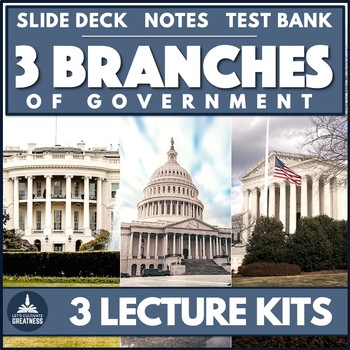3 Branches of Government PPT Lectures with Quizzes & Guided Notes
- Zip
- Google Apps™

What educators are saying
Products in this Bundle (3)
Also included in
- Transform your high school Civics class with this inquiry-driven and project-based complete done-for-you semester course.Whether you're new to Civics or looking to upgrade to something powerful, this course will cultivate intrigue and skills in your students to be informed and engaged change-makers.Price $167.97Original Price $201.80Save $33.83
Description
Confidently teach all about the three branches-- Congress and the legislative branch, the President and executive branch, and the Supreme Court and the judicial branch with this complete Google Slides/PowerPoint lecture kit bundle!
Each lecture comes with ready-to-go guided notes, a 50-question test bank, and slide-by-slide teacher scripts.
Scroll down to see a complete list of all the topics covered in each lecture slide deck.
If you're brand new to Civics or need to upgrade what you have, this is ready-to-go and fully loaded for you!
Greatness is being an informed and engaged citizen.
And when new concepts are presented in bite-sized chunks, with visuals and immediate real-life examples, it sticks. This lets you spend more time doing the projects and activities that students enjoy.
This bundle guides your Legislative, Executive, and Judicial branch units. Or use it with my Three Branches of Government unit.
Each of these three branches lecture kit includes:
70-95-Slide Lecture
- Clean, modern look in Google Slides
- Extensive teacher scripts on every slide
- Embedded animations to focus attention
- "Pause and Talk" reflection & processing questions at the end of each segment
2 Differentiated Versions of Accompanying Notes
- 4-Page Guided Notes for on-level students
- 4-Page More Scaffolded Fill-in-the-Blank Notes for support students
- Print PDF and Google Doc files of both sets
- Answer Key
50-Question Test Bank
- Easily copy/paste questions to build quizzes and formative checks natively into your LMS or other platform
- Fill-in-the-blank, matching, short-answer, and open-ended questions included
- Answer key included too!
Legislative Branch Lecture Kit covers:
- Terminology: legislature, legislator, legislative
- Comparison to other nations & parliament system
- The bicameral system
- Founder's intentions with an "upper" & "lower" house
- 17th Amendment
- Senator requirements & specific powers
- House of Representative requirements & specific powers
- Political party makeup of current Congress
- Senate Leadership & Current Members:
- President and President Pro Tempore
- Majority & Minority Leaders
- Your state's Senators - Current House Leadership & Current Members:
- Speaker of the House
- Majority & Minority Leaders
- Your Congressional District's Representative - Expressed or enumerated powers
- Pass a budget, spend money, collect taxes, trade
- Maintain military, declare war
- Maintain post offices, roads, citizenship, patents & copyrights
- Maintain federal lands
- Necessary & Proper Clause - How a bill becomes a law
- Submission
- In Committee
- Floor Debate; filibuster
- President sign, veto
Executive Branch Lecture Kit covers:
- Founders' intentions with creating a single President
- Job qualifications & the debate over "natural-born" requirement
- 22nd Amendment & term limits
- Comparison with other countries' leader set-ups
- Official roles:
- Head of Government -- appointments, budget, State of the Union
- Chief Diplomat -- treaties, UN & G7 meetings, Logan Act
- Commander in Chief -- undeclared wars & the Wars Power Act, military attacks, the nuclear football - Unofficial roles:
- Head of State -- State diner, Presidential Medal of Freedom, Easter Egg Roll
- Head of Party -- campaigning for other candidates
- World Leader -- UN Security Council member, world treaties, international policies - Expressed Presidential powers:
- Signing/vetoing bills
- Granting pardons
- Appointing federal judges - Implied Presidential powers:
- Executive orders
- Executive agreements
- Executive privilege - Role & Duties of the Vice President
- Role and members of the Cabinet
- 25 executive departments and agencies
Judicial Branch Lecture Kit covers:
- Founders' intentions with creating an isolated judiciary
- Lifetime appointments, "in good behavior" standing
- Unofficial requirements expected of a federal judge
- Comparison with other countries' requirements for judges
- Judiciary Act of 1789
- District & Circuit courts
- Presidential appointment with Senate confirmation
- Marbury v. Madison & judicial review
- Textualist, Orginialist, & Living Constitutionalist interpretations
- Judicial restraint & judicial activism
- Supreme Court ruling "tests" to set precedents
- Majority & Minority Opinions
- Original & Appellate jurisdiction
- Overturning Supreme Court rulings, constitutional amendments
- Current members & leaning of the Supreme Court
- Landmark cases highlighted to illustrate concepts listed
- Dred Scott v. Sanford
- Riley v. California
- Dobbs v. Jackson
- Obergefell v. Hodges
- Virginia v. Tennessee
- Brandenburg v. Ohio
- Schenk v. United States
- Brown v. Board
- Plessy v. Ferguson
- Texas v. Johnson
Brand new to teaching Civics / Government and need everything?
Civics & American Government course bundle teach this inquiry-driven and project-based semester course with confidence!
This listing is for one license for regular, non-commercial classroom use by a single teacher only. Commercial use like online teaching (ex. Outschool) or sharing with other teachers (ex. shared drive, in a Facebook group, in a professional development training) is strictly prohibited.
By purchasing a license to this resource, you have access to all future updates at no cost, available under “My Purchases." Multiple and transferable licenses are available for purchase. PDF files are uneditable, other files have editing abilities, unless otherwise stated. All files are protected under federal copyright laws.
To request a complete terms of use prior to purchase or if you have any questions about this resource, please leave a question below under Product Q&A.






